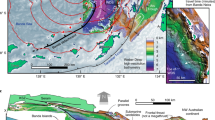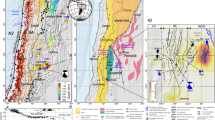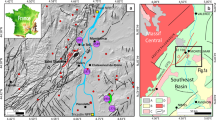Abstract
On 12 January 2010, a Mw 7.0 earthquake struck the Port-au-Prince region of Haiti. The disaster killed more than 200,000 people and caused an estimated $8 billion in damages, about 100% of the country’s gross domestic product1. The earthquake was initially thought to have ruptured the Enriquillo–Plantain Garden fault of the southern peninsula of Haiti, which is one of two main strike-slip faults inferred to accommodate the 2 cm yr−1 relative motion between the Caribbean and North American plates2,3. Here we use global positioning system and radar interferometry measurements of ground motion to show that the earthquake involved a combination of horizontal and contractional slip, causing transpressional motion. This result is consistent with the long-term pattern of strain accumulation in Hispaniola. The unexpected contractional deformation caused by the earthquake and by the pattern of strain accumulation indicates present activity on faults other than the Enriquillo–Plantain Garden fault. We show that the earthquake instead ruptured an unmapped north-dipping fault, called the Léogâne fault. The Léogâne fault lies subparallel to—but is different from—the Enriquillo–Plantain Garden fault. We suggest that the 2010 earthquake may have activated the southernmost front of the Haitian fold-and-thrust belt4 as it abuts against the Enriquillo–Plantain Garden fault. As the Enriquillo–Plantain Garden fault did not release any significant accumulated elastic strain, it remains a significant seismic threat for Haiti and for Port-au-Prince in particular.
This is a preview of subscription content, access via your institution
Access options
Subscribe to this journal
Receive 12 print issues and online access
$259.00 per year
only $21.58 per issue
Buy this article
- Purchase on Springer Link
- Instant access to full article PDF
Prices may be subject to local taxes which are calculated during checkout




Similar content being viewed by others
References
Haiti Earthquake Post Disaster Needs Assessment: Assessment of damage, losses, general and sectoral needs. http://siteresources.worldbank.org/INTLAC/Resources/PDNA_Haiti-2010_Working_Document_EN.pdf (2010).
Mann, P., Taylor, F, Edwards, R. & Ku, T. Actively evolving microplate formation by oblique collision and sideways motion along strike-slip faults: An example from the northeastern Caribbean plate margin. Tectonophysics 246, 1–69 (1995).
Dixon, T et al. Relative motion between the Caribbean and North American plates and related boundary zone deformation. J. Geophys. Res. 103, 15157–15182 (1998).
Pubellier, M., Mauffret, A., Leroy, S., Vila, J. & Amilcar, H. Plate boundary readjustment in oblique convergence: Example of the Neogene of Hispaniola, Greater Antilles. Tectonics 19, 630–648 (2000).
McCann, W. R. in Estimating the Threat of Tsunamogenic Earthquakes and Earthquake-Induced Landslide Tsunami in the Caribbean (eds Aurelio, M. & Philip, L.) 43–65 (World Scientific Publishing, 2006).
Mann, P., Burke, K. & Matumoto, T. Neotectonics of Hispaniola: Plate motion, sedimentation, and seismicity at a restraining bend. Earth Planet. Sci. Lett. 70, 311–324 (1984).
Calais, E. & de Lépinay, B. From transtension to transpression along the northern Caribbean plate boundary off Cuba: Implications for the recent motion of the Caribbean plate. Tectonophysics 186, 329–350 (1991).
Calais, E., Béthoux, N. & de Lépinay, B. From transcurrent faulting to frontal subduction: A seismotectonic study of the northern Caribbean plate boundary from Cuba to Puerto Rico. Tectonics 11, 114–123 (1992).
Calais, E., Perrot, J. & de Lépinay, B. Strike-slip tectonics and seismicity along the northern Caribbean plate boundary from Cuba to Hispaniola. Geol. Soc. Am. Spec. Pap. 326, 125–169 (1998).
DeMets, C. et al. GPS geodetic constraints on Caribbean-North America plate motion. Geophys. Res. Lett. 27, 437–441 (2000).
Calais, E. & de Lépinay, B. Semiquantitative modeling of strain and kinematics along the Caribbean/North America strike-slip plate boundary zone. J. Geophys. Res. 98, 8293–8308 (1993).
Mann, P. et al. Oblique collision in the northeastern Caribbean from GPS measurements and geological observations. Tectonics 21, 1057 (2002).
Dolan, J., Mullins, H. & Wald, D. Active tectonics of the north-central Caribbean: Oblique collision, strain partitioning, and opposing subducted slabs. Geol. Soc. Am. Spec. Pap. 326, 1–62 (1998).
Calais, E. et al. Strain partitioning and fault slip rates in the northeastern Caribbean from GPS measurements. Geophys. Res. Lett. 29, 1856 (2002).
Manaker, D. M. et al. Interseismic plate coupling and strain partitioning in the northeastern Caribbean. Geophys. J. Int. 174, 889–903 (2008).
Prentice, C., Mann, P., Peña, L. & Burr, G. Slip rate and earthquake recurrence along the central septentrional fault, north American–Caribbean plate boundary, Dominican Republic. J. Geophys. Res. 108, 2149 (2003).
McCaffrey, R. in Plate Boundary Zones (eds Stein, S. & Freymueller, J.) 101–122 (AGU Geodynamics Series, Vol. 30, 2002).
Wells, D. & Coppersmith, K. New empirical relationships among magnitude, rupture length, rupture width, rupture area, and surface displacement. Bull. Seismol. Soc. Am. 4, 974–1002 (1994).
Hayes, G. P. et al. Complex rupture during the 12 January 2010 Haiti Earthquake. Nature Geosci. 10.1038/NGEO977 (2010).
Prentice, C. et al. Seismic hazard of the Enriquillo-Plantain Garden fault in Haiti inferred from palaeoseismology. Nature Geosci. 10.1038/NGEO991 (2010).
http://earthquake.usgs.gov/earthquakes/recenteqsww/Quakes/us2010rja6.php.
Hanks, T. & Krawinkler, H. The 1989 Loma Prieta earthquake and its effects: Introduction to the special issue. Bull. Seismol. Soc. Am. 81, 1415–1423 (1991).
BienAimé-Momplaisir, R. Contribution to the Geologic Study of the Eastern Part of the Massif of La Hotte (Presqu’Ile du Sud d’Haiti). Structural Synthesis of the Margins of the Peninsula from Seismic Data. Doctoral thesis, Pierre et Marie Curie University, Paris, France (1986).
Farr, T. G. & Kobrick, M. Shuttle Radar Topography Mission produces a wealth of data. Eos Trans. AGU 81, 583–585 (2000).
Jonsson, S., Zebker, H. & Segall, P. Fault slip distribution of the Mw 7.2 Hector Mine earthquake estimated from satellite radar and GPS measurements. Bull. Seismol. Soc. Am. 92, 1377–1389 (2002).
Cervelli, P., Murray, M. & Segall, P. Estimating source parameters from deformation data, with an application to the March 1997 earthquake swarm off the Izu Peninsula, Japan. J. Geophys. Res. 106, 11217–11237 (2001).
Acknowledgements
The results presented here owe to many collaborators, contributors and friends in Haiti, in particular the National System for Disaster Risk Reduction (A. Nazaire) and the Civil Protection Agency (A. Jean-Baptiste), the Bureau of Mines and Energy (D. Anglade) and the National Center for Geospatial Information (G. Porcena and B. Piard). M. Jeannite and F. S. Preux from the Bureau of Mines and Energy carried out the bulk of the GPS fieldwork in Haiti. We thank D. Anglade (General Director) and S. L. Mildor (Director for Geology) from the Bureau of Mines and Energy for their constant support. The post-earthquake GPS survey benefited from field support from D. Sarah Stamps and E. Chaussard. UNAVCO provided outstanding support to the field operations in Haiti. A. Holsteinson (Holasa Inc.) carried out the 2009 and 2010 GPS measurements in the Dominican Republic. The ALOS data were provided by GEO’s Geohazard Supersites and are copyrighted by the Ministry of Economy, Trade and Industry of Japan and Japan Aerospace Exploration Agency. This research was supported by grants from the National Science Foundation (grants no 0409487 and RAPID no 1024990 to E.C., no 0408978 to G.M./P.J.) and the National Disaster Risk Management System Development Program-UNDP Haiti.
Author information
Authors and Affiliations
Contributions
E.C. conceived the study and prepared the main manuscript, with contributions from all co-authors. All co-authors contributed to the interpretation. In addition, R.M., A.F. and G.M. contributed to the G.P.S. field work, F.A., S.J. and S-H.H. contributed the InSAR analysis, S.J. contributed the coseismic slip estimation and error analysis and P.J., T.D., R.M. and C.P. provided background context for the study. All authors discussed the results and implications and commented on the manuscript at all stages.
Corresponding author
Ethics declarations
Competing interests
The authors declare no competing financial interests.
Supplementary information
Supplementary Information
Supplementary Information (PDF 839 kb)
Rights and permissions
About this article
Cite this article
Calais, E., Freed, A., Mattioli, G. et al. Transpressional rupture of an unmapped fault during the 2010 Haiti earthquake. Nature Geosci 3, 794–799 (2010). https://doi.org/10.1038/ngeo992
Received:
Accepted:
Published:
Issue Date:
DOI: https://doi.org/10.1038/ngeo992
This article is cited by
-
Two multi-temporal datasets to track debris flow after the 2008 Wenchuan earthquake
Scientific Data (2022)
-
Tsunami coastal hazard along the US East Coast from coseismic sources in the Açores convergence zone and the Caribbean arc areas
Natural Hazards (2022)
-
Active fault characterization and seismotectonic zoning of the Hispaniola island
Journal of Seismology (2021)
-
Review of Tsunami Hazard Potential for Gulf of Aqaba, Egypt
Journal of the Geological Society of India (2021)
-
Seismic S-wave coda attenuation in the Dominican Republic as a tool for seismic hazard mitigation
Natural Hazards (2020)



